Niacin (a.k.a. Nicotinic Acid, Vitamin B3) is a water-soluble vitamin in the B series, and a coenzyme or cosubstrate in many biological reduction and oxidation reactions, thus required for energy metabolism. Furthermore, it is needed for normal function of the digestive system, skin, and nerves.
Being water-soluble, it is stored in the liver in small quantities, but excess amounts will be expelled quickly. This means we need an adequate, ongoing (daily) supply to keep B3 levels in the optimal range.
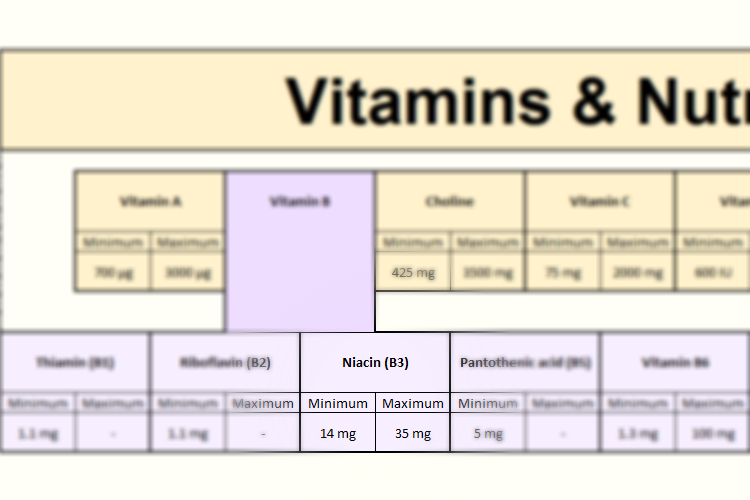 Niacin in Focus - FooDosage Nutrition Calculator
Niacin in Focus - FooDosage Nutrition Calculator
This article will cover the recommended intake levels, why we want to reach those levels, the dangers of overconsumption, and which foods are richest in Niacin. As a twist, we sort foods by their nutrient to calorie ratios, as opposed to the more common per 100 gram values. But more on the reasoning behind that decision later.
Note that all recommended intake figures below are based on the needs of a 31 year old non-pregnant, non-lactating woman on a 2000 kilocalorie diet. Your personal requirements may differ (wildly). One way to figure out your individual needs, including calories per day, is the FooDosage Nutrition Calculator. It's free, by the way.
For the original, full, and up to date article, visit foodosage.com
Contents
1 Recommended Niacin Intake
1.1 Importance of an Adequate Niacin Intake (Dangers of a Deficiency)
1.2 Risks of an Excessive Niacin Consumption (Side Effects)
1.3 Special Considerations
2 Top 12 Niacin (Vitamin B3) Food Sources
2.1 Portabella Mushrooms
2.2 Yellowfin Tuna
2.3 White (Button) Mushrooms
2.4 Beef Liver
2.5 Anchovies
2.6 Turkey Breast
2.7 Chicken Breast
2.8 Deer Loin
2.9 Bell Peppers
2.10 Asparagus
2.11 Okra
2.12 Sun Dried Tomatoes
Recommended Niacin Intake
The recommended intake range for Niacin, as set by the National Academy of Sciences:
Recommended minimum intake (RDA): 14 mg per day
Upper limit: 35 mg per day
The UL for niacin applies to synthetic forms obtained from supplements, fortified foods, or a combination of the two.
Note that your personal requirements may differ depending on your age, sex, pregnancy-, and lactation status.
Importance of an Adequate Niacin Intake (Dangers of a Deficiency)
Due to the essential role Vitamin B3 plays in our bodies, the symptoms of a severe deficiency are quite grim.
Light deficiencies can cause nausea, skin and mouth lesions, anemia, headaches, and tiredness, as well as a slowed metabolism and a lowered tolerance to cold.
Severe deficiencies can lead to Pellagra, a deadly (if untreated) disease. The symptoms include:
- Nausea
- Scaly skin lesions
- Diarrhea
- Delusions
- Death
Risks of an Excessive Niacin Consumption (Side Effects)
As a water-soluble vitamin, excess Niacin is usually expelled without complication. As opposed to fat soluble vitamins, liver toxicity is not a danger.There is no evidence of adverse effects from the consumption of naturally occurring Niacin in foods. The upper limit for niacin applies to synthetic forms obtained from supplements, fortified foods, or a combination of the two. Adverse effects from an overdose of Vitamin B3 containing supplements include:
- Flushing
- Increased blood sugar level
- Headache
- Abdominal pain
- Diarrhea
- Nausea
- Rhinitis
- Liver damage
- Peptic ulcers
- Skin rashes
Special Considerations
Extra Niacin may be required by persons treated with hemodialysis or peritoneal dialysis, or those with malabsorption syndrome.
Top 12 Niacin (Vitamin B3) Food Sources
The highest concentrations of Niacin are usually found in mushrooms, meats, fish, some vegetables, and whole grains.
Some choice examples of Vitamin B3 rich foods:
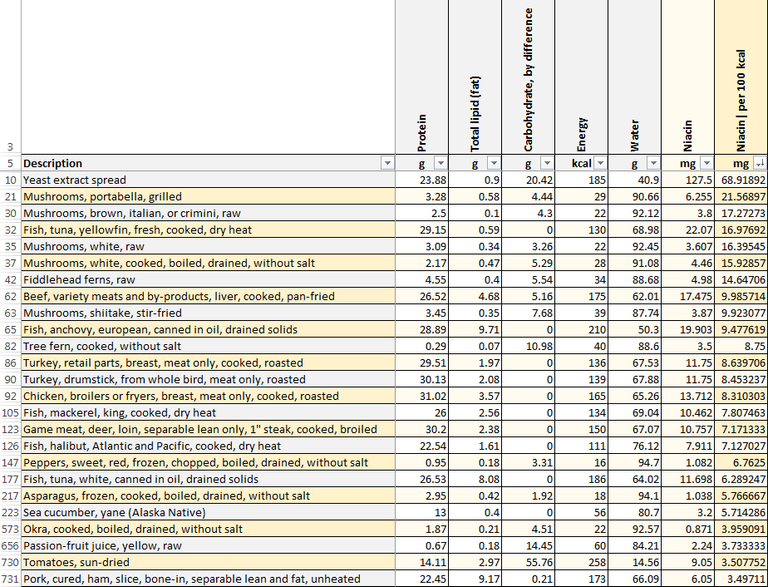 Niacin Leaderboard - FooDosage Nutrition Calculator
Niacin Leaderboard - FooDosage Nutrition Calculator
Note that for this ranking, the foods were sorted by their nutrient/calorie contents, as opposed to the more common nutrient/gram sorting method. This is because per calorie values correct for water content, and satiation. Example: Butter may contain more Vitamin A than Spinach per 100 grams, but eating the 120 grams of spinach necessary to reach the minimum recommended amount of Vitamin A is by far more feasible (and recommendable) than to eat the 100 grams of butter required for the same amount of Vitamin A.
Portabella Mushrooms
Niacin (B3) per 100g (grilled): 6.26 mg (45% of recommended minimum intake.)Niacin (B3) per 100 kcal: 21.57 mg (Corrects for water content and satiation.)
Calories per 100g: 29 kcal
Many mushrooms contain very high amounts of Niacin, but Portabella take the crown.
Fun fact: Portabella mushrooms are just fully grown common brown/button musrooms, but they do contain higher concentrations of some nutrients. As such, common brown (or white) mushrooms are a good budget alternative.
Portabella Mushrooms are also a great source of:
- Copper – at 0.39 mg / 100g (43% of RMI)
- Selenium – at 21.9 µg / 100g (40% of RMI)
- Riboflavin (B2) – at 0.4 mg / 100g (37% of RMI)
- Pantothenic acid (B5) – at 1.26 mg / 100g (25% of RMI)
Yellowfin Tuna
Niacin (B3) per 100g (cooked): 22.1 mg (158% of recommended minimum intake.)Niacin (B3) per 100 kcal: 17 mg (Corrects for water content and satiation.)
Calories per 100g: 130 kcal
First among fish when it comes to Niacin contents, yellowfin tuna is also a great source of complete protein (29g, 60%). As a lean fish, tuna doesn't contain as much EPA & DHA Omega-3 acids as fatty fish like salmon do, but the amounts aren't negligible at all: 0.12 g / 100 g, 48% of the recommended minimum. Plus, they taste delicious.
As with all fish, please buy only MSC certified products.
Yellowfin tuna is also an excellent source of:
- Selenium – at 108 µg / 100g (197% of RMI)
- Cyanocobalamin (B12) – at 2.35 µg / 100g (98% of RMI)
- Vitamin B6 – at 1.04 mg / 100g (80% of RMI)
- Phosphorus – at 333 mg / 100g (48% of RMI)
White (Button) Mushrooms
Niacin (B3) per 100g (boiled): 4.16 mg (32% of recommended minimum intake.)Niacin (B3) per 100 kcal: 15.9 mg (Corrects for water content and satiation.)
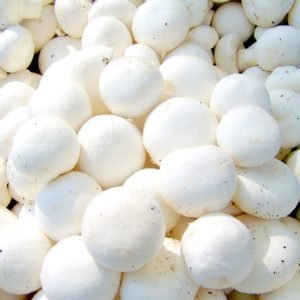 White Button Mushrooms
White Button Mushrooms
Calories per 100g: 28 kcal
A mutation of immature Portabella mushrooms (brown button), favored because of its "cleaner" look, white button mushrooms, as many other mushrooms, make for a great Portabella alternative.
White mushrooms are also a great source of:
- Copper – at 0.5 mg / 100g (56% of RMI)
- Pantothenic acid (B5) – at 2.16 mg / 100g (43% of RMI)
- Riboflavin (B2) – at 0.3 mg / 100g (27% of RMI)
- Selenium – at 11.9 µg / 100g (22% of RMI)
Beef Liver
Niacin (B3) per 100g (fried): 17.5 mg (125% of recommended minimum intake.)
Niacin (B3) per 100 kcal: 9.99 mg (Corrects for water content and satiation.)
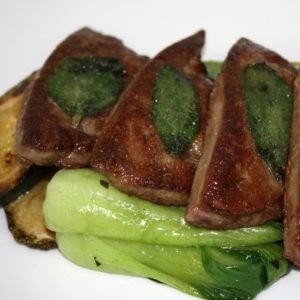 Beef Liver
Beef Liver
Calories per 100g: 175 kcal
Liver in general is extremely rich in Vitamin B3, but beef liver takes the crown.
Beware: Apart from Niacin, liver is so rich in vitamin A, that you should only eat small amounts to not exceed the upper limit. Since Vitamin A is fat soluble, this can be taken as a weekly average. Assuming your remaining diet is very low in Vitamin A, you should probably not exceed 100-250 grams of liver per week.
But Vitamin A is not the only reason to limit liver consumption to very small amounts. Heavy metals such as arsenic, cadmium and lead, as well as pesticides tend to collect in farm animals’ livers. Try to only buy grass fed and organic to get “cleaner” livers, apart from all the other arguments for buying organic foods in general.
Beef liver is also a fantastic source of:
- Cyanocobalamin (B12) – at 83.1 µg / 100g (3464% of RMI)
- Copper– at 14.6 mg / 100g (1621% of RMI)
- Vitamin A – at 7744 µg / 100g (1106% of RMI. WARNING: The upper limit is 3000 µg.)
- Riboflavin (B2) – at 3.43 mg / 100g (311% of RMI)
- Pantothenic acid (B5) – at 6.94 mg / 100g (139% of RMI)
Anchovies
Niacin (B3) per 100g (canned): 19.9 mg (142% of recommended minimum intake.)Niacin (B3) per 100 kcal: 9.48 mg (Corrects for water content and satiation.)
Calories per 100g: 210 kcal
Next up on the list of Niacin rich fish, we have anchovies. They may be behind tuna in terms of B3 contents, but they make up for it in other ways. Anchovies contain a lot more EPA & DHA n-3 fatty acids (2.05 g, 822%), and as they are low in the food chain, we can worry less about mercury, dioxins and PCBs. Of course, they also contain lots of protein, at 28.9 grams per hundred.
Go ahead and load your pizza with (MSC certified) anchovies in good conscience, but beware of the high sodium content (depends on manufacturer.)
Anchovies are also a great source of:
- Selenium – at 68.1 µg / 100g (124% of RMI)
- Copper – at 0.34 mg / 100g (38% of RMI)
- Cyanocobalamin (B12) – at 0.88 µg / 100g (37% of RMI)
- Phosphorus – at 252 mg / 100g (36% of RMI)
- Riboflavin (B2) – at 0.36 mg / 100g (33% of RMI)
Moroccan and Croatian anchovies are not MSC certified, but many independent audits such as Friends of the Sea list those fisheries as sustainable.
Turkey Breast
Niacin (B3) per 100g (roasted): 11.8 mg (84% of recommended minimum intake.)Niacin (B3) per 100 kcal: 8.64 mg (Corrects for water content and satiation.)
Calories per 100g: 136 kcal
Like chicken, but bigger and tougher. Also very slightly richer in Niacin (per calorie).
Turkey breast is also a great source of:
- Cyanocobalamin (B12) – at 1.76 µg / 100g (73% of RMI)
- Vitamin B6 – at 0.83 mg / 100g (64% of RMI)
- Protein – at 29.5 g / 100g (60% of RMI)
- Selenium – at 30.7 µg / 100g (56% of RMI)
Chicken Breast
Niacin (B3) per 100g (roasted): 13.7 mg (98% of recommended minimum intake.)Niacin (B3) per 100 kcal: 8.31 mg (Corrects for water content and satiation.)
Calories per 100g: 165 kcal
Like Turkey, but smaller and more tender. Also very slightly less rich in Niacin (per calorie).
Chicken breast is also a great source of:
- Protein – at 31 g / 100g (64% of RMI)
- Selenium – at 27.6 µg / 100g (50% of RMI)
- Vitamin B6 – at 0.6 mg / 100g (46% of RMI)
- Phosphorus – at 228 mg / 100g (33% of RMI)
Deer Loin
Niacin (B3) per 100g (broiled): 10.8 mg (77% of recommended minimum intake.)Niacin (B3) per 100 kcal: 7.17 mg (Corrects for water content and satiation.)
Calories per 100g: 150 kcal
Mmmh, venison. Like Turkey and chicken, except not.
Even though the results of recent studies into the dangers associated with red meat may have been blown out of proportion, and it is perfectly fine and healthy to consume, the key is moderation. Two to three portions of around 200 grams of lean red meat per week are not only delicious, but can be a healthy source of protein. At 2.4 grams of fat per 100g, this certainly qualifies as lean.
Deer loin is also a great source of:
- Cyanocobalamin (B12) – at 1.83 µg / 100g (76% of RMI)
- Protein – at 30.2 g / 100g (62% of RMI)
- Vitamin B6 – at 0.76 mg / 100g (58% of RMI)
- Riboflavin (B2) – at 0.51 mg / 100g (47% of RMI)
- Zinc – at 3.63 mg / 100g (45% of RMI)
- and many more..
Bell Peppers
Niacin (B3) per 100g (boiled, red): 1.08 mg (8% of recommended minimum intake.)Niacin (B3) per 100 kcal: 6.76 mg (Corrects for water content and satiation.)
Calories per 100g: 16 kcal
A great addition to any salad, bell peppers come with a healthy helping of Niacin. At least when measured per calorie. The 100 gram values may seem underwhelming, but consider how many peppers you could eat before you feel full. Alternatives to bell peppers are many other kinds of peppers, such as jalapenos.
Bell peppers are also a great source of:
- Vitamin C – at 41.2 mg / 100g (55% of RMI)
- Vitamin A – at 96 µg / 100g (14% of RMI)
- Vitamin B6 – at 0.11 mg / 100g (8% of RMI)
Asparagus
Niacin (B3) per 100g (boiled): 1.04 mg (7% of recommended minimum intake.)Niacin (B3) per 100 kcal: 5.77 mg (Corrects for water content and satiation.)
Calories per 100g: 18 kcal
Ah, asparagus. A great option to lose weight, gain Niacin, and nauseate whomever uses the bathroom after you at the same time. Considering the calorie count, asparagus also contains a fair amount of dietary fiber (2 g).
Asparagus is also a great source of:
- Vitamin K – at 80 µg / 100g (89% of RMI)
- Folate (B9) – at 135 µg / 100g (34% of RMI)
- Vitamin C – at 24.4 mg / 100g (33% of RMI)
- Copper – at 0.11 mg / 100g (12% of RMI)
- Riboflavin (B2) – at 0.1 mg / 100g (9% of RMI)
Okra
Niacin (B3) per 100g (boiled): 0.87 mg (6% of recommended minimum intake.)Niacin (B3) per 100 kcal: 3.96 mg (Corrects for water content and satiation.)
Calories per 100g: 22 kcal
Okra may not exactly be the most exciting of veggies, but they do help with achieving our daily Niacin levels and are rich in other nutrients as well.
Okra is also a great source of:
- Vitamin K – at 40 µg / 100g (44% of RMI)
- Vitamin C – at 16.3 mg / 100g (22% of RMI)
- Manganese – at 0.29 mg / 100g (16% of RMI)
- Vitamin B6 – at 0.19 mg / 100g (14% of RMI)
Sun Dried Tomatoes
Niacin (B3) per 100g: 9.05 mg (65% of recommended minimum intake.)Niacin (B3) per 100 kcal: 3.51 mg (Corrects for water content and satiation.)
Calories per 100g: 256 kcal
Mmmh, smells like the 80s.. Sun dried tomatoes were actually not bad as fads go, considering they're one of the leading vegetarian options for Niacin (as are canned tomatoes). Not only that, but they do make for a delicious appetizer, for example as bruschetta, combined with olive paste. The fad may have ended in the 90s, but that doesn't mean we can't still enjoy sun dried tomatoes.
Sun dried tomatoes are also a great source of:
- Copper – at 1.42 mg / 100g (158% of RMI)
- Manganese – at 1.85 mg / 100g (103% of RMI)
- Potassium – at 3427 mg / 100g (73% of RMI)
- Magnesium – at 194 mg / 100g (61% of RMI)
For the original, full, and up to date article, visit foodosage.com
Bon Appetit :-)
Sources:
http://www.nationalacademies.org/hmd/Activities/Nutrition/SummaryDRIs/DRI-Tables.aspx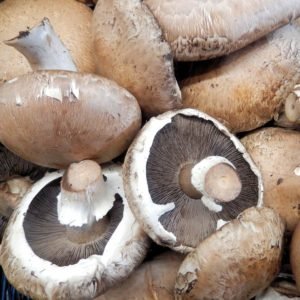
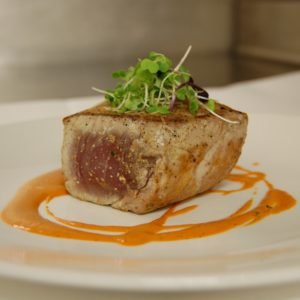
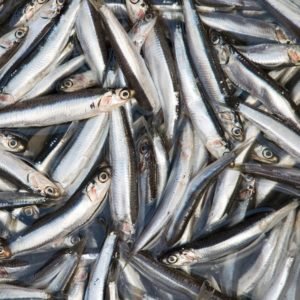
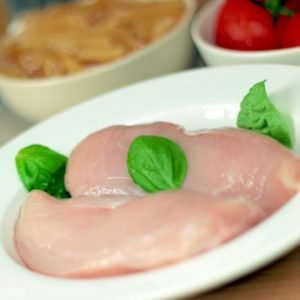
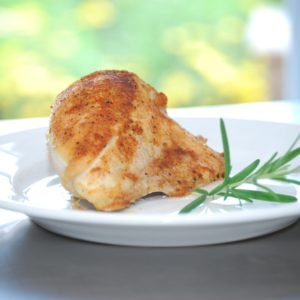
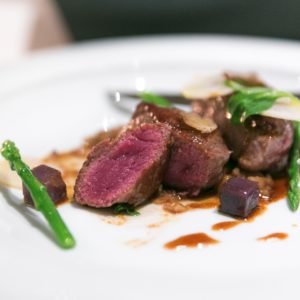
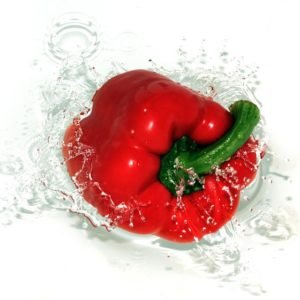


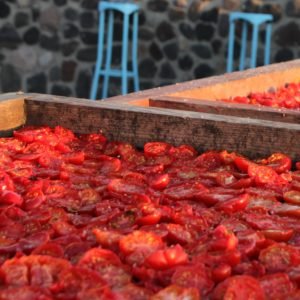
Hi! I am a robot. I just upvoted you! I found similar content that readers might be interested in:
http://www.foodosage.com/niacin-vitamin-b3-top-foods-rda-dangers-side-effects/
Yes, yes, yes, that's mine. But it's impressive you found it before google.
Please visit my Blog and leave comment thank you
metamucilbenefits.com/side-effects-and-metamucil-benefits